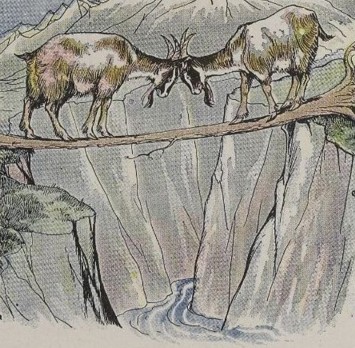PART A_1
Let’s learn vocabulary. Listen and repeat the words and the sentences with your tutor.
PART A_2
| 1. chasm | /KAZ-uhm/ |
| -a deep opening in earth or rock | |
| The chasm below the bridge is frightening. | |
| 2. tremble | /TREM-buhl/ |
| -a slight shake | |
| He’s scared of suspension bridges because of their trembles. | |
| 3. torrent | /TAWR-uhnt/ |
| -a stream of water flowing with great rapidity and violence | |
| The torrent swept the animals away. | |
| 4. stubbornness | /STUHB-ern-nes/ |
| -the quality of being difficult to move, change, or deal with | |
| His refusal to talk is from simple stubbornness. | |
| 5. misfortune | /mis-FAWR-chuhn/ |
| -bad luck | |
| Her misfortune was her downfall. |
PART B_1
Let’s read the story. Please read them aloud, and I will check your pronunciation and intonation.
PART B_2
The Two Goats

Two Goats, frisking gayly on the rocky steeps of a mountain valley, chanced to meet, one on each side of a deep chasm through which poured a mighty mountain torrent. The trunk of a fallen tree formed the only means of crossing the chasm, and on this not even two squirrels could have passed each other in safety. The narrow path would have made the bravest tremble. Not so our Goats. Their pride would not permit either to stand aside for the other.
One set her foot on the log. The other did likewise. In the middle, they met horn to horn. Neither would give way, and so they both fell, to be swept away by the roaring torrent below.
It is better to yield than to come to misfortune through stubbornness.
PART C_1
Let’s answer comprehension questions. Please answer them based on the story.
PART C_2
| 1. | Where did the two Goats meet? |
| 2. | What hindered the two Goats from saving themselves? |
| 3. | What did they do in order to try and survive? |
PART D_1
Let’s discuss the story. Please answer the questions below and express your opinions.
PART D_2
| 1. | Why do you think the two Goats did not survive? |
| 2. | What do you think the Goats should have done to survive? |
| 3. | Why is it bad to be stubborn? |
| 4. | How can you stop someone from being stubborn? |
| 5. | What is your understanding of the lesson’s fable? |
REVIEW AND FEEDBACK
Now, let us review the things that you learned in this lesson.
ではこのレッスンで学んだことを振り返りましょう。
(Please give a short feedback on how your student did on your class.)
| Grammar 文法 |
Pronunciation 発音 | Vocabulary 単語 |
Comprehension 理解 |
|
|---|---|---|---|---|
 GOOD GOOD |
文法の誤りはほとんどなく、完全な文章で話すことができる | ほとんどの単語をはっきりと正しく発音することができる | 習った表現を適切に使うことができる | 文章を理解し、質問に正しく答えることができる |
 FAIR |
文法の誤りはあるが、完全な文章で話すことができる | 発音の練習が必要な言葉がいくつかある | たまにミスはあるが、習った表現を適切に使うことができる | 文章を完全に理解するのは難しく、質問に正しく答えられないときもある |
 POOR |
文章で話すのは難しく、単語だけで話すことができる | 発音の練習が必要である | 習った単語と表現を少しだけ使うことができる | 文章を理解するのは難しく、質問に答えるのは難しい |
Parts of this lesson material are based on:
An eBook from The Project Gutenberg.
This eBook is for the use of anyone anywhere at no cost and with almost no restrictions whatsoever. You may copy it, give it away or re-use it under the terms of the Project Gutenberg License included with this eBook or online at www.gutenberg.org
An eBook from The Project Gutenberg.
This eBook is for the use of anyone anywhere at no cost and with almost no restrictions whatsoever. You may copy it, give it away or re-use it under the terms of the Project Gutenberg License included with this eBook or online at www.gutenberg.org